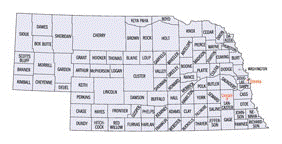Geography
Date of this Version
1977
Abstract
Stated in a positive sense, the specific objectives of this study are:
(1) To collect and summarize information about the task of defining critical environmental areas in other states;
(2) To describe and review some procedures for defining criticality and for delineating critical areas; and
(3) To assemble data pertaining to resource inventories in Nebraska.
The results of Objective 1 are found throughout this report plus the references cited in the Bibliography. The two sources mentioned most frequently in this report are the one by the Center for Natural Areas, Office of International and Environmental Programs, Smithsonian Institute (which is abbreviated CEA Reference Guide in subsequent references in this report) and Report Eight of the Critical Resources Information Program (CRIP) by the Institute for Environmental Studies, University of Wisconsin-Madison. Objective 2 is achieved in Chapter II where the issue of "criticality" is examined and in Chapter IV when some successful processes for delineating critical areas are described. Chapter III, which discusses several elements of lithe environment" and reports on the inventors status of each in Nebraska, deals particularly with Objective 3.
The procedure that is recommended here for delineating critical environmental areas in Nebraska is not an easy one. It commences with a concept about places in the State that should receive special attention because incompatible and harmful uses of the land can cause environmental damage having more than local importance. It ends by recommending a few specific areas where land uses should be carefully managed. Between the initial concept and the final definition of areas are many decisions based on a multitude of data and the diversity of citizen assessments about land-use goals in Nebraska.
The decisions about which areas should be selected for critical evaluation must involve both citizens at the local level and experts with technical information. This combination is essential because the nature of the task requires input about land-use goals and about environmental interrelationships. A procedure used in another state (Wisconsin) for this kind of task appears very appropriate for defining CEA in Nebraska.
As participants discuss the applicability of specific areas, they will face the issues of criticality discussed in the first portion of Chapter II. Personnel charged with the responsibility of designing a measurement scheme will need to consider the problems summarized in the latter part of Chapter II. Hopefully the background information about data sources and about differentiated areas according to selected phenomena that was described in Chapter III can serve as a working base for subsequent analyses.
Nevertheless, in spite of whatever aids are obtained from this report, the task of defining critical environmental areas in Nebraska will be difficult and will expose conflicting and controversial goals in the use of our land. But, given the general importance of the State's rural components, the increasing interaction among all segments of society, and the dependence of humans on their earth environment, the task is essential. Furthermore, the effort is worthwhile because the ultimate objective is the improvement of life in Nebraska.


Comments
Occasional Papers No. 3
Department of Geography
University of Nebraska
Lincoln, Nebraska
July 1977